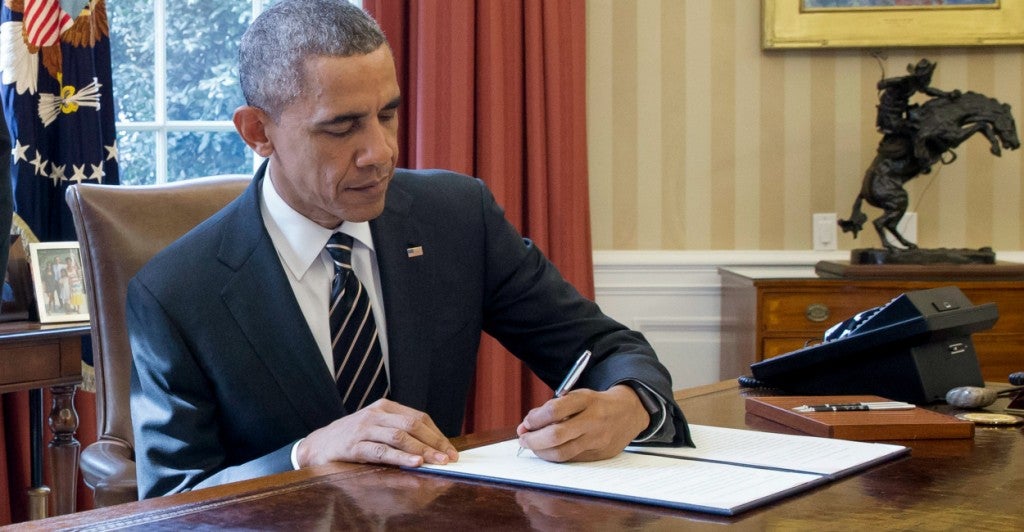The Obama administration announced Tuesday its plans to commit the U.S. to greenhouse gas emissions of 26-28 percent (from 2005 levels) by 2025 as part of a United Nations climate agreement set for this December in Paris.
The announcement is being heralded as America’s stepping up to “lead the way.” The Paris agreement is to replace the 1997 Kyoto Protocol, which the U.S. rejected.
Obama’s commitment, which was initially laid out in a lopsided agreement with China last November, doesn’t stop with cutting U.S. greenhouse gas emissions by 26-28 percent by 2025. The Obama administration’s submission to the U.N. is meant to set up a “pathway from 2020 to deep, economy-wide emission reductions of 80 percent or more by 2050. The target is part of a longer range, collective effort to transition to a low-carbon global economy as rapidly as possible.”
To achieve the goal, the Obama administration proposed a package of regulations which it is already well underway in implementing: fuel efficiency mandates for cars and trucks, energy efficiency mandates for everything from buildings to kitchen appliances, methane emissions regulations, an executive order to cut emissions and energy use by the federal government, and the capstone Clean Power Plan regulating state carbon dioxide emissions.
President Obama has spoken openly about his intentions to work around legislators if they did not act on climate change. His administration has dared Congress to try to stop the Clean Power Plan.
Obama’s offer to the U.N.:
- Ignores serious, honest scientific questions about the extent (or lack thereof) of global warming. Data have yet to show that the world is headed toward accelerating and catastrophic global warming. The world has not seen any warming in the 21st century and for much of the 1990s even while carbon dioxide emissions have steadily increased. Nor does the U.N.’s Intergovernmental Panel on Climate Changes claim that extreme weather events are increasing in frequency. Further, it is very much up for debate about how sensitive the climate is to carbon dioxide. In other words, carbon dioxide may not even be the problem, assuming there is one.
- Challenges the Constitution. As one of Obama’s former law school professors testified, the Clean Power Plan is an unconstitutional “sleigh-of-hand [that] offends democratic principles by avoiding political transparency and accountability.” Regardless of where an individual stands on global warming, the ends do not justify the means if the means take the very foundation of American government and democracy as a casualty. Americans should further be very concerned about what the Paris agreement is ultimately to accomplish. At another preliminary climate conference in Doha in 2012, Executive Secretary for the U.N.’s conventions on climate change Christiana Figueres said, “It must be understood that what is occurring here, not just in Doha but in the whole climate change process, is a complete transformation of the economic structure of the world.”
- Sets the U.S. on course for incredible economic hardship with very little, if any, environmental benefit. If finalized, the Clean Power Plan will have almost zero impact on global temperatures, even though the plan is billed as a global warming initiative. It guts energy diversity by eliminating coal and replacing it with natural gas, which is as foolish as staking your retirement nest egg on one kind of investment. The plan threatens electric reliability and forces Americans to pay more for less power. It will shrink the economy and hit manufacturing particularly hard and ultimately consume the very resources Americans have to protect and improve their environments.
- Withholds from others the health and opportunity made possible by affordable, reliable energy. While elitists will go to Paris to barter and swap carbon dioxide emissions cuts for green financing, there are billions of people all around the world with little or no access to affordable, reliable energy and the opportunities energy unlocks. Energy heats the homes and meals, runs the schools and hospitals, and creates the products and opportunities that help lift people out of poverty. Yet too many climate policies make these opportunities further out of reach by restricting the use of conventional, reliable energy sources and forcing the use of more expensive, less available technologies. In the process they thwart the very means by which to improve environmental health as well.
- Gives the impression of leadership. Supporters praised the U.S.-China climate deal as one that “raised global hopes that developed and developing nations can come together to fight climate change.” Fighting together is an interesting way to put it as so far the many talks leading up to Paris have focused on developed countries like the U.S. cutting emissions (and their economies with it), providing financial support to developing nations (at $100 billion a year), and subsidizing politically preferred technologies. China on the other hand, and others likely to follow, “intends” to level off emissions “around” 2030, according to the deal. What some are praising as American leadership looks a lot more like unilateral disarmament.
Obama has often been accused of leading from behind on important issues. In this case, however, he is leading headlong in exactly the wrong direction.
